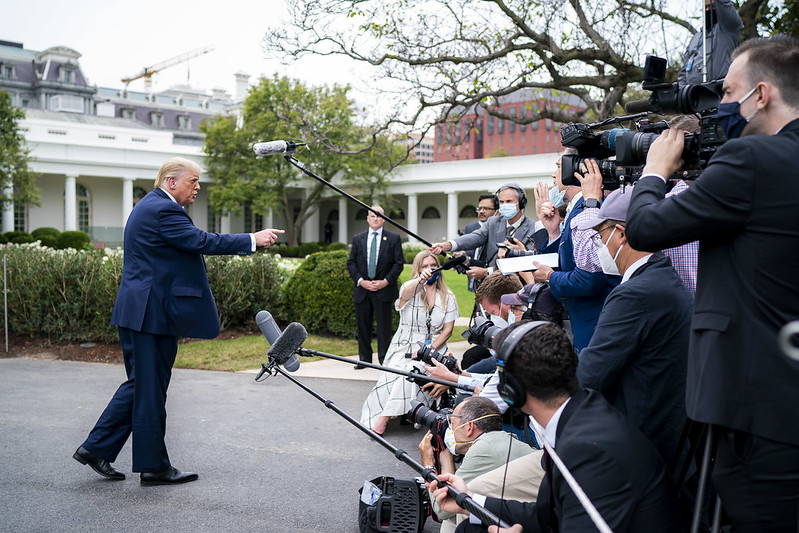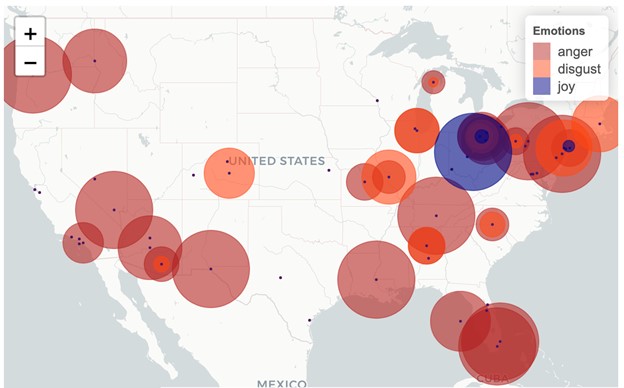
Donald Trump went negative and then he tested positive.
Trump visited chaos on the first campaign debate. Then Covid-19 did the same to his campaign.
The Donald’s ability—call it a skill—to shout and shift is a central feature of his presidency.
Trump at full volume is the consistent element that runs from his
inauguration speech in January 2016 (‘This American carnage stops right here and stops right now’) to the
presidential debate with Joe Biden in September 2020. The noise of a great showman proclaiming his greatness. What a ride.
Beyond the policy crunches and crashes, I’ve approached these four years from two frames: as a viewer and as a journalist.
The viewer perspective mixes amazement with acknowledgement: wow, this guy is good at what he does.
As a journalist about to reach 50 years in hackdom, my response has been rueful puzzlement. How do you report on this guy using the normal rules? The debate merely illustrates the tactic he’s deployed every day of his presidency.
The rules of hackdom (report on the president accurately, nail the facts) say the tsunami of Trump untruths should have washed him away. In July, the
Washington Post fact-check said Trump had reached the grand total of
20,000 false or misleading claims. In the halls of hackdom, all those falsehoods and fabrications should be the end of the story. Of course, it isn’t.
Hacks face cascading crashes. Old models for paying for journalism crumble and burn. The digital disruption destroys the editor’s power as the information gatekeeper. Now the rules of the reporting game—objectivity, the facts, balance—don’t seem to decide the game.
Trump isn’t interested in policy or theory. And he does
‘alternative facts’, a phrase that epitomises the shimmering, shifting sands on which the
very stable genius stands.
Trump’s
game theory is from
Dungeons and Dragons. He’s playing as a ‘chaotic neutral’, ‘an individualist, neither good nor evil, who cares little for rules or precedence and thrives in spontaneity’.
The president isn’t a person; he’s a TV character. That insight is from James Poniewozik, chief television critic of the
New York Times. TV was born at the same time as Trump, Poniewozik writes, and TV is his soulmate. Trump
thinks like a TV camera:
If you want to understand what President Trump will do in any situation, then, it’s more helpful to ask: What would TV do? What does TV want?
It wants conflict. It wants excitement. If there is something that can blow up, it should blow up. It wants a fight. It wants more. It is always eating and never full.
The first presidential debate was TV Trump again crashing into the journos. The hacks had a hard time handling it. The president as TV character is both creature and would-be commander of the viewers. The problem for the hacks was reporting on a debate where the defining line from Biden was, ‘Will you
shut up, man? This is so unpresidential.’
My go-to American media columnist, the ever-sharp
Jack Shafer, captured the problem of journos trying to intuit the impact of the Trump–Biden debate:
Never assume that the audience is more easily swayed by mass media messages than you are unless you’ve collected genuine data that proves that point. The people ‘out there’ are more savvy than we give them credit for.
If you’re a member of the press and you want to talk about what the ‘others’ think, at least take a stab at actually talking to them.
My answer to the collect-genuine-data instruction to hacks draws on the work of a very smart Australian, Sean Farrell, an astronomer who hunted black holes and is now a data scientist who hunts anything interesting. He’s working for a tech start-up called
Receptiviti that’s turning
algorithms loose on language (emails, tweets, transcripts of speeches) to develop tools the media can use for analysis and reporting.
The image below represents anger, disgust and joy in tweets targeting Trump around 12 minutes into the debate, when the moderator, Chris Wallace, pointed out that the president had never come up with a plan to replace Obamacare.
 Image: Receptiviti, Timeline of emotional reaction on Twitter to first US presidential debate. Used with permission.
Image: Receptiviti, Timeline of emotional reaction on Twitter to first US presidential debate. Used with permission.
Here’s the
app Dr Farrell built to
visualise the response from Americans on Twitter to the debate, and here’s some of his analysis of emotional reactions as told to
The Strategist:
- Good feeling, bad feeling, emotionality and sentiment—All are highly correlated with tweet volume for Trump, but not for Biden. Biden sees a significant drop in all of these in the period when Trump hammers him on law and order, and Biden argues, ‘Most cops are good cops; there’s just some bad apples.’
- Anger—The spike in angry tweets about Biden happens after he tells Trump to shut up. There were no such significant spikes for Trump, but his average anger level is higher than for Biden. Anger slowly trends down over the debate, perhaps indicative of debate fatigue.
- Disgust—For Trump, disgust trends steadily upwards throughout the debate with spikes at particular moments: at Biden’s ‘will you shut up, man’ comment; when Trump attacked Biden for using the word ‘smart; at Biden’s comment, ‘He’s the racist’; and straight after Trump’s ‘stand back and stand by’ comment. In contrast, disgust at Biden trends downwards from the start of the debate until the point he tells Trump to shut up, and then it trends upwards from there (but still much less than Trump’s disgust).
The data on good feeling, bad feeling, emotionality and sentiment, Farrell comments, are all indicators of strong reactions, and they correlated with volume for Trump but not for Biden. That confirms what we already know: the polarising effect of Trump.
The Farrell summary: ‘People were unhappy with the bellicose exchanges and became increasingly fed up with the constant berating and belittling by both candidates, though they were particularly responsive to Trump’s behaviour.’
Journos always want to know who won. So Farrell constructed a good-versus-bad metric, with 100% being good and 0% being bad.
Across the entire US, pre-debate tweets about Biden had a good-versus-bad metric of 42.6%, while after the debate that rose to 50.0%. As for Trump, his good versus bad pre-debate was 52.8%, while after it was 51.1%. So, from this I guess you could say that good feeling for Trump went down slightly, by 1.7%, while good feeling for Biden went up by 7.4%.
The viewers joined the hacks in being unimpressed with the shouting.
 Print This Post
Print This Post
